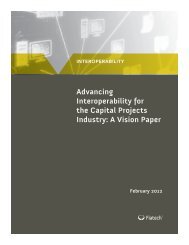An Introduction to ISO 15926 November 2011 - iRINGToday
An Introduction to ISO 15926 November 2011 - iRINGToday
An Introduction to ISO 15926 November 2011 - iRINGToday
You also want an ePaper? Increase the reach of your titles
YUMPU automatically turns print PDFs into web optimized ePapers that Google loves.
absorbs the unconscious mental frequencies from this energy, more or less, as<br />
food. Its excrement is a so-called telepathic matrix of conscious thought frequencies<br />
combined with the nerve signals from the speech centers of the brain<br />
which supplied them, which is picked up by the mind of the host. Basically, then,<br />
if you stick a Babel fish in your ear, you can instantly understand anything said<br />
<strong>to</strong> you in any language.<br />
Bringing this metaphor in<strong>to</strong> the field of plant design, <strong>ISO</strong> <strong>15926</strong> is similar <strong>to</strong> a Babel fish in that<br />
it translates the descriptions of plant objects from one company’s database <strong>to</strong> that of another.<br />
The important thing <strong>to</strong> note here is that the meaning of all the terms is maintained. You do not<br />
have <strong>to</strong> rely on the context of the information <strong>to</strong> know what individual terms mean.<br />
The metaphor of the Babel fish is a pretty good one, but there is a slight difference. The Babel<br />
fish translates thoughts directly from Vogon in<strong>to</strong> English in one operation. <strong>ISO</strong> <strong>15926</strong> will do<br />
this in two steps using a middle, neutral layer. If you used <strong>ISO</strong> <strong>15926</strong> <strong>to</strong> translate Vogon <strong>to</strong><br />
English, it would first translate Vogon in<strong>to</strong> intermediate standard descriptions and then from<br />
these standard descriptions in<strong>to</strong> English.<br />
Using a middle layer of standard descriptions is an important step we will examine in more<br />
detail, but briefly the middle layer is what makes it all work. Each organization’s “Babel fish”<br />
(which we will call an <strong>ISO</strong> <strong>15926</strong> interface from now on) only has <strong>to</strong> understand these standard<br />
descriptions, not the descriptions in the proprietary operations of every business partner.<br />
<strong>ISO</strong> <strong>15926</strong> Is Like HTML<br />
In case you don’t know what Hypertext Markup Language (HTML) is, you can rest assured that<br />
you are a part of a very large majority. HTML is the common language of the World Wide Web.<br />
Every web page you have seen is written with some variant of it. If everyone involved in plant<br />
design, construction, and operations were <strong>to</strong> use <strong>ISO</strong> <strong>15926</strong> <strong>to</strong> exchange information about<br />
plant objects, we would have an equivalent <strong>to</strong> the HTML experience—but between machines.<br />
For instance, if you want <strong>to</strong> look at the web page of a pump manufacturer you don’t need <strong>to</strong><br />
know anything beyond the web site address of the company. When your browser connects <strong>to</strong><br />
the web site, it assumes that what it finds will be encoded in HTML. Of course, it will be—if the<br />
manufacturer wants <strong>to</strong> get any business through the web page—because HTML is the standard<br />
format of the World Wide Web. In addition, it does not matter which browser you use.<br />
Internet Explorer, Firefox, Safari, Opera, and Netscape are all written <strong>to</strong> understand HTML.<br />
Imagine the hassle if you first had <strong>to</strong> contact the pump manufacturer and ask for the encoding<br />
format, and then instruct your IT folks <strong>to</strong> write a transla<strong>to</strong>r program, before you could access<br />
the web site? Of course, you would not do it. <strong>An</strong>d of course the pump manufacturer would not<br />
make a web page like this in the first place because no one else would do it either.<br />
This metaphor does a good job of describing what the average user will have <strong>to</strong> know about<br />
<strong>ISO</strong> <strong>15926</strong> as well. In the same way that most people who use the World Wide Web do not<br />
need <strong>to</strong> know about HTML, most users of <strong>ISO</strong> <strong>15926</strong> will not have <strong>to</strong> know about it <strong>to</strong> exchange<br />
information. When <strong>ISO</strong> <strong>15926</strong> is mature, it will simply be built in<strong>to</strong> the software we will<br />
all use. Engineers will be able <strong>to</strong> exchange information much more easily than they do now,<br />
and very few of them will need <strong>to</strong> know that the standard exists.<br />
On the other hand, many web sites <strong>to</strong>day are actually written in HTML. This metaphor implies<br />
INTRODUCTION<br />
4



